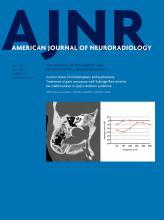Index by author
Wan, J.
- EDITOR'S CHOICENeurointerventionOpen AccessParent Artery Reconstruction for Large or Giant Cerebral Aneurysms Using the Tubridge Flow Diverter: A Multicenter, Randomized, Controlled Clinical Trial (PARAT)J.-m. Liu, Y. Zhou, Y. Li, T. Li, B. Leng, P. Zhang, G. Liang, Q. Huang, P.-f. Yang, H. Shi, J. Zhang, J. Wan, W. He, C. Liang, G. Zhu, Y. Xu, B. Hong, X. Yang, W. Bai, Y. Tian, H. Zhang, Z. Li, Q. Li, R. Zhao, Y. Fang and K. Zhao for the PARAT investigatorsAmerican Journal of Neuroradiology May 2018, 39 (5) 807-816; DOI: https://doi.org/10.3174/ajnr.A5619
This was a prospective, multicenter, randomized trial conducted at 12 hospitals throughout China. Enrolled adults with unruptured large/giant intracranial aneurysms were randomly assigned (1:1) to receive either Enterprise stent-assisted coiling or Tubridge flow diverter implantation. The primary end point was complete occlusion at 6-month follow-up, while secondary end points included technical success, mortality, target vessel–related stroke, aneurysm bleeding, in-stent stenosis, parent artery occlusion, and the frequency of all adverse events. The results of 6-month follow-up imaging included complete occlusion rates of 75.34% versus 24.53% for the Tubridge and stent-assisted coiling groups, respectively. This trial showed a higher rate of large and giant aneurysm obliteration with the Tubridgeflow diverter over Enterprise stent-assisted coiling. However, this higher obliteration rate came at the cost of a nonsignificantly higher rate of complications.
Wang, C.
- FELLOWS' JOURNAL CLUBAdult BrainOpen AccessBrain MRI Characteristics of Patients with Anti-N-Methyl-D-Aspartate Receptor Encephalitis and Their Associations with 2-Year Clinical OutcomeT. Zhang, Y. Duan, J. Ye, W. Xu, N. Shu, C. Wang, K. Li and Y. LiuAmerican Journal of Neuroradiology May 2018, 39 (5) 824-829; DOI: https://doi.org/10.3174/ajnr.A5593
The authors enrolled 53 patients with anti-N-methyl-D-aspartate receptor encephalitis and performed 2-year follow-up. Brain MRIs were acquired for all patients at the onset phase. The brain MR imaging manifestations were classified into 4 types—type 1: normal MR imaging findings; type 2: only hippocampal lesions; type 3: lesions not involving the hippocampus; and type 4: lesions inboth the hippocampus and other brain areas. Twenty-eight (28/53, 53%) patients had normal MR imaging findings (type 1), and the others (25/53, 47%) had abnormal MRI findings—type 2: 7 patients (13%); type 3: 7 patients (13%); and type 4: 11 patients (21%). The presence of hippocampal lesions and relapse was associated with poor outcome.
Wang, Y.
- Adult BrainOpen AccessFast and Robust Unsupervised Identification of MS Lesion Change Using the Statistical Detection of Changes AlgorithmT.D. Nguyen, S. Zhang, A. Gupta, Y. Zhao, S.A. Gauthier and Y. WangAmerican Journal of Neuroradiology May 2018, 39 (5) 830-833; DOI: https://doi.org/10.3174/ajnr.A5594
Watanabe, K.
- Adult BrainYou have accessSignal Change of Acute Cortical and Juxtacortical Microinfarction on Follow-Up MRIM. Miyata, S. Kakeda, T. Yoneda, S. Ide, K. Watanabe, J. Moriya and Y. KorogiAmerican Journal of Neuroradiology May 2018, 39 (5) 834-840; DOI: https://doi.org/10.3174/ajnr.A5606
White, T.J.
- Pediatric NeuroimagingOpen AccessCerebellar Growth Impairment Characterizes School-Aged Children Born Preterm without Perinatal Brain LesionsK. Pieterman, T.J. White, G.E. van den Bosch, W.J. Niessen, I.K.M. Reiss, D. Tibboel, F.E. Hoebeek and J. DudinkAmerican Journal of Neuroradiology May 2018, 39 (5) 956-962; DOI: https://doi.org/10.3174/ajnr.A5589
Wick, C.
- FELLOWS' JOURNAL CLUBHead and Neck ImagingYou have accessEvaluation of the Normal Cochlear Second Interscalar Ridge Angle and Depth on 3D T2-Weighted Images: A Tool for the Diagnosis of Scala Communis and Incomplete Partition Type IIT.N. Booth, C. Wick, R. Clarke, J.W. Kutz, M. Medina, D. Gorsage, Y. Xi and B. IsaacsonAmerican Journal of Neuroradiology May 2018, 39 (5) 923-927; DOI: https://doi.org/10.3174/ajnr.A5585
The second interscalar ridge notch angle and depth were measured on MR imaging in normal ears by a single experienced neuroradiologist. The images of normal ears were then randomly mixed with images of ears with incomplete partition II malformation for 2 novice evaluators to measure both the second interscalar ridge notch angle and depth in a blinded manner. For the mixed group, interobserver agreement was calculated, normal and abnormal ear measurements were compared, and receiver operating characteristic curves were generated. The 94 normal ears had a mean second interscalar ridge angle of 80.86° and depth of 0.54mm with the 98th percentile for an angle of 101° and a depth of 0.3 mm. In the mixed group, agreement between the 2 readers was excellent, with significant differences found between normal and incomplete partition type II ears for angle and depth on average. The authors conclude that a measured angle of >114° and a depth of the second interscalar ridge notch of ≤0.31 mm suggest the diagnosis of incomplete partition type II malformation and scalacommunis.
Wiesmann, M.
- NeurointerventionYou have accessUnder Pressure: Comparison of Aspiration Techniques for Endovascular Mechanical ThrombectomyO. Nikoubashman, D. Wischer, H.M. Hennemann, M. Büsen, C. Brockmann and M. WiesmannAmerican Journal of Neuroradiology May 2018, 39 (5) 905-909; DOI: https://doi.org/10.3174/ajnr.A5605
Wiesner, E.L.
- Spine Imaging and Spine Image-Guided InterventionsYou have accessPercutaneous CT-Guided Biopsies of the Cervical Spine: Technique, Histopathologic and Microbiologic Yield, and Safety at a Single Academic InstitutionE.L. Wiesner, T.J. Hillen, J. Long and J.W. JenningsAmerican Journal of Neuroradiology May 2018, 39 (5) 981-985; DOI: https://doi.org/10.3174/ajnr.A5603
Wischer, D.
- NeurointerventionYou have accessUnder Pressure: Comparison of Aspiration Techniques for Endovascular Mechanical ThrombectomyO. Nikoubashman, D. Wischer, H.M. Hennemann, M. Büsen, C. Brockmann and M. WiesmannAmerican Journal of Neuroradiology May 2018, 39 (5) 905-909; DOI: https://doi.org/10.3174/ajnr.A5605
Wu, X.
- NeurointerventionYou have accessManagement of Small Unruptured Intracranial Aneurysms: A Survey of NeuroradiologistsA. Malhotra, X. Wu, B. Geng, D. Hersey, D. Gandhi and P. SanelliAmerican Journal of Neuroradiology May 2018, 39 (5) 875-880; DOI: https://doi.org/10.3174/ajnr.A5631








